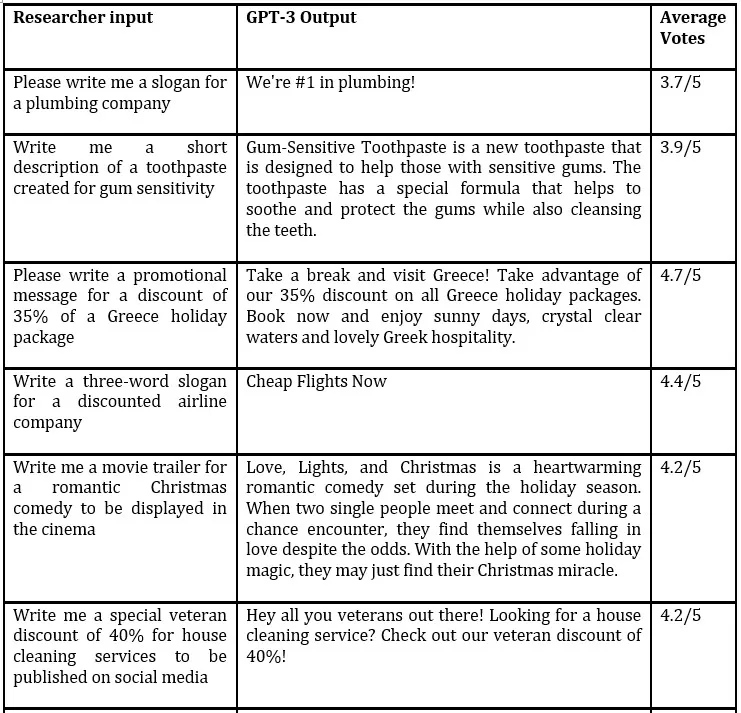Introduction
Artificial intelligence (AI) has been around since the 1950s, but only recently have individuals seen its widespread use. It is a simulation of human intelligence in machines that were created to think and act like humans. AI can be defined as “the science of making machines do things that would otherwise require human intelligence.” This technology is being used in various ways across multiple industries. AI can help companies make better decisions about their products and services. In fact, many large corporations now rely heavily on AI to make business decisions. AI is used in everything from customer service to marketing content to product design. This paper focuses on the ethics of AI writing systems for marketing purposes and how technology is already being used to help businesses improve their marketing strategies, increase sales, and better understand their customers. The theories will build upon strategies used for decision-making in the marketing business, AI content writing for marketing purposes, the use of GPT-3 models, and the concerns surrounding AI systems, such as GPT-3 models. Furthermore, figuring out if humans will find differences in traditional marketing descriptions or between AI intelligent types.
The main body of the paper
Four Types of AI
There are four types of AI or AI-based systems that are important to understand: reactive, machines, limited memory machines, theory of mind, and self-aware AI (Joshi 2019). Reactive AIs are the simplest type of artificial intelligence. They have no memory and can only react to stimuli they receive from their environment. Reactive AIs are often used in video games and other interactive media. These models can be downloaded, traded, passed around, and loaded easily into a developer’s toolkit. Limited memory AIs are capable of learning from experience but lack any form of long-term memory. This makes them unable to retain information about events after they were created. Limited memory AIs are usually programmed to learn from specific experiences rather than general knowledge. There are three limited memory types: Reinforcement learning, Long Short Term Memory (LSTMs), and Evolutionary Generative Adversarial Networks (E-GAN). Theory of mind AIs can understand what others think and believe. They can infer what people want based on their actions and words. The idea of mind AIs is commonly used in social robots. A machine learning model that does a lot for an individual directed at achieving a task, such as Alexa and Siri. Self-Aware AIs can recognize themselves in mirrors and understand their own emotions. Self-aware AIs are extremely rare due to the complexity of creating this kind of AI. This type of AI is still being worked on to advance further. A self-aware intelligence would be beyond an individual who has independent intellect, and it is up to humans to negotiate terms with the entity created. AI has become one of the most robust software tools for the future.
AI Content Writing
AI content writing is growing exponentially. AI content writing is a type of article written specifically for search engines like Google, Bing, Yahoo, etc. These articles are usually used to promote websites, blogs, products, services, brands, events, news, etc. AI enables writers to create content more efficiently and strategically to produce effective output. Other content marketing tasks can include conducting keyword research, monitoring trending topics, content writing, and analyzing content performance. They can be used for both paid and free campaigns and allow for many ways to write AI-type articles.
AI has emerged as an essential pillar for socio-economic development and social progress (Zhang & Li 2021). AI content tools market is increasing due to the increased need for content, while the tools help marketers scale up the content production while ensuring total efficiency in the process (Özkardes-Cheung 2021). Benefits of using AI content writing include improved quality, productivity, better user experience, and more.
GPT-3 from OpenAI
The third generation Generative Pre-Trained Transformer (GPT-3) is a neural network machine learning model trained using Internet data to generate any type of text. GPT-3 was developed by OpenAI, a non-profit artificial intelligence research company based out of San Francisco, California. The model has 175 billion parameters, the values that a neural network tries to optimize during training (Heaven 2020). Its purpose is to expand the realities of AI past automating repetitive and manual tasks. One of the most impressive features of GPT-2 is the meta-learner; it has learned information where an individual can ask a natural language to perform a new task, and it understands what it has to do. OpenAI’s team reports that GPT-3 was so good that people found it hard to distinguish new stories from humans’ prose (Hutson 2021). It could answer trivial questions, correct grammar, solve mathematical problems and even generate computer code if users told it to perform a programming task (Hutson 2021). OpenAI is always seeking to evolve the applications of AI into specific niches that require more precise human thought. Machine learning is a subset of AI that allows computers to learn the same way people do, only faster, without explicitly programming.
Marketing with GPT-3
GPT-3 can be integrated into any sized business for marketing and content process purposes to save time with automation. It can summarize long texts, create blog content, write articles, and translate the language. GPT-3 achieves strong performance on many natural language processing (NLP) datasets, including translation, question-answering, and cloze tasks, as well as several functions that require on-the-fly reasoning or domain adaptation, such as unscrambling words, using a novel term in a sentence, or performing 3-digit arithmetic (Heaven 2020). Studies have found that GPT-3 can generate samples of news articles that human evaluators have difficulty distinguishing from articles written by humans (Heaven 2020). The machine learning model has the potential to outperform humans in content creation, especially in writing short-form texts; however, GPT-3 can produce long-form content as well. A study suggests a conceptual framework for the role of machine learning methods in marketing research. It is a multi-faceted task with a focus called for on five aspects: method, data, usage, issue, and theory (Ma 2020). GPT-3’s language prediction algorithm attempts to identify the best word choice based on the output that has been written before. Content writing requires human effort and thought to communicate to the audience to help them relate. GPT-3 is a valuable tool for that purpose and provides first draft content to proofread further by a writer. The content creation process is much faster, providing writers with more time to focus on other projects. Marketing businesses can make use of the capabilities of the GPT-3 model to meet their marketing tool needs and goals in a more cost-efficient and time-saving way. A recent study showed GPT-3 strength in generating text that accurately emulates interactive, informational, and influential content that could be utilized for radicalizing individuals into violent far-right extremist ideologies and behaviors (Mcguffie & Newhouse 2020). GPT-3 can help marketers identify what customers want, how customers think, and what motivates them.
How can AI Help Write Content for Marketing Purposes?
AI marketing uses AI technology to create personalized messages that are relevant to individual customers. This can include anything from sending out targeted emails to your existing customer base to creating content based on their interests, likes, and dislikes. Content marketing is probably one of the most well-known forms of digital marketing. Many businesses create content; however, few know what content works best for them. To make matters worse, some companies don’t use content at all. That’s where artificial intelligence comes into play. AI is becoming increasingly popular and is helping businesses find out what type of content performs best.
Three-stage strategic framework
A three-stage strategic planning framework based on the marketing research strategy-marketing action cycle was proposed in a study. The cycle views strategic planning as a circular process, starting from conducting marketing research to understand the market, the firm, the competitors, and the customers, developing strategies for segmentation, targeting, and positioning, and designing specific marketing actions to execute the strategy (Huang & Rust 2020). The cycle was created not to stop marketing actions. The execution of the marketing actions feedbacks to marketing research as market data allow for a continuous cycle of marketing research-strategy-action (Huang & Rust 2020). The marketing strategy stage is used for the strategic decision of segmentation, targeting, and positioning. It involves gathering information about the target audience, competitors, and current trends. Marketing action stage is used for the benefits of standardization, personalization, and realization, individually or synergistically. This is where marketers need to decide which AI to use for specific marketing actions. Data can be taken that have been collected and begin to formulate a plan, such as, who the target audience is, what products are going to see, and how it’s going to be promoted. The benefits of applying AI to strategic marketing decision-making include: increasing speed of decision-making, especially in response to new data being available or competitive threats emerging; allowing companies to capture the benefits of more powerful market positions earlier; identification of missing data; increased rationality, particularly via removal or reduction of cognitive bias by decision-makers; creation of common basis for decision making; incorporation of learning from experiences; and higher quality management of marketing projects (Joshi 2019).
Different Areas of AI for Marketing
There are different areas of marketing content that are utilized to promote marketing businesses. Many various programs are available to use for text writing AI, and some of them are simple while others are more complex. It is a valuable tool for writers that are short on time, enabling writers to write faster and more. The process of AI writing works in several ways depending on the writer and program. They all fall into one of two categories: one used by the writer and one used by the program. The first category that the writer uses is similar to the writing process. It has the writer go through all the different steps, such as brainstorming their ideas, creating a rough outline, writing up the story, and editing and revising. Once done, the AI program will go through the process and make all the required changes that the writer made (Darapaneni et al., 2021). The second category used by the program is more complex and is done by a computer program. Some programs use AI software, some are complex and use different algorithms, and others are less complex. All create AI that is indistinguishable from human-written work (Darapaneni et al., 2020). AI writing is used for many different things with various programs and applications. The most common factor for AI writing is to improve human writers’ work. AI writing benefits allow marketers to save time, increase productivity, create targeted content, boost SEO efforts, and save money. A recent study found that content creators could create profiles on various platforms and upload an entire portfolio for machine-based evaluation and cataloging without worrying about a breach of intellectual property infringement of creative license (Bujor 2021).
AI was designed to have multiple intelligences, such as humans, for different tasks. Multiple AI intelligence plays a crucial role in all three strategic marketing stages: mechanical, thinking, and feeling. Mechanical AI is designed for automating repetitive and routine tasks (Huang & Rust 2020), Including: analyzing sales reports, tracking trends, and predicting future events. Mechanical AI can help companies understand how their products are performing and what changes they need to make to improve them. Thinking intelligence is designed for processing data to arrive at new conclusions or decisions (Huang & Rust 2020). It has the ability to think about problems logically and come up with solutions including helping companies identify potential issues and find ways to solve them before becoming a significant problem. Feeling AI is designed for two-way interactions involving humans and/or for analyzing human feelings and emotions (Huang & Rust 2020). It can empathize with customers and know what they want, helping companies develop products that people actually want.
Concerns
Many individuals are concerned that it will replace humans in the future of content marketing; however, at the moment, it is more about helping individuals create content efficiently and is still up for debate. A study suggests that two ethical principles guide the design of AI writing systems: transparency about machine presence and critical data awareness, methodological reflexivity about rhetorical context, and omissions in the data that need to be provided by a human agent or accounted for machine learning (Mckee & Porter 2020). In addition, GPT-3 model does not understand writing well and sometimes generates uncontrollable content, and training the GPT-3 model requires a large amount of computing power, data, and capital investment (Zhang & Li 2021). This is something to consider when working with AI writing systems to learn about rhetorical contexts, or it will miss an essential component of communication and understanding that the GPT-3 model needs massive amounts of data input, which is why humans are still required. However, as AI becomes more prevalent, marketers should prepare themselves for a shift in the way they approach marketing.
Research
The ability of an AI to replace human creative thinking is the milestone of a perfect AI. The ultimate test for an AI is for it to be able to recreate conversation and sentences in such a way that it’s impossible to differentiate them from the work of a human (Turing test).
In order to test the usability of the GPT-3 software for marketing content, we’ve asked the AI to create a number of sentences from various marketing fields, from slogans to product descriptions. To analyze their quality and usability in a business environment, we’ve decided to run a quantitative research study with the help of an online survey where each of the AI outputs were rated with the help of a semantic differential scale, respondents being asked to rate with a grade from 1-5 the quality and usability of the output in a real marketing scenario, as described by the researcher’s input.
The survey was published online and distributed across a wide range of online channels to a broad audience, reaching a wide segment of respondents from different industries, ages, education levels and genders. We’ve used a probabilistic sampling methodology, with a general confidence level of 95%. The survey has been answered fully by 240 respondents. We did not collect demographic data from the respondents as we believe the usability of the GPT-3 in a marketing environment should be determined by the general population in a quantitative manner.
Table 1. Research



Conclusions
Over the years, artificial intelligence has achieved such a massive improvement in its technology to the point where it’s almost impossible to differentiate a human response to an AI. There are so many fields that can use this kind of software to improve a good portion of their work processes, the marketing industry being one of the few pioneers that can successfully use AI for all kinds of purposes, marketing communications and content writing being a few of the use cases.
Our research proved that, depending on the quality of the input, the AI can create incredibly accurate marketing messages, to the point where they can be used commercially without any kind of human improvement. The respondents appreciated the vast majority of the responses thus demonstrating their quality.
On a personal note, the authors of this research were incredibly impressed by how well AI can write different slogans, descriptions and general communication that can be used for marketing purposes. We strongly believe that businesses can (if not already) successfully implement OpenAI GPT-3 into their marketing communication strategy.
Acknowledgment
We, the authors, would love to deeply thank Cosmin Gheorghita for providing us with access to auser-friendly interface of the OpenAI GPT-3 model that made this research possible.
References
- Bujor, A. (2021). What is AI Writing & How it Can Improve Your Content. [online] Unbounce. Available at: https://unbounce.com/marketing-ai/ai-writing/ [Accessed 18 May 2022].
- Darapaneni, N., Bhakuni, C., Bhatt, U., Purohit, K., Sardna, V., Chakraborty, P. and Paduri, A. (2021). Matching Writers to Content Writing Tasks. [online] Available at: https://arxiv.org/pdf/2204.09718.pdf [Accessed 18 May 2022].
- Heaven, W.D. (2020). OpenAI’s new language generator GPT-3 is shockingly good—and completely mindless. [online] MIT Technology Review. Available at: https://www.technologyreview.com/2020/07/20/1005454/openai-machine-learning-language-generator-gpt-3-nlp/ [Accessed 18 May 2022].
- Huang, M.-H. and Rust, R.T. (2020). A strategic framework for artificial intelligence in marketing. Journal of the Academy of Marketing Science, [online] 49(1). doi:10.1007/s11747-020-00749-9.
- Hutson, M. (2021). Robo-writers: the rise and risks of language-generating AI. Nature, 591(7848), pp.22–25. doi:10.1038/d41586-021-00530-0.
- Joshi, N. (2019). 7 Types Of Artificial Intelligence. [online] Forbes. Available at: https://www.forbes.com/sites/cognitiveworld/2019/06/19/7-types-of-artificial-intelligence/?sh=44d2b77d233e [Accessed 18 May 2022].
- Ma, L. and Sun, B. (2020). Machine learning and AI in marketing – Connecting computing power to human insights. International Journal of Research in Marketing, 37(3). doi:10.1016/j.ijresmar.2020.04.005.
- Mcguffie, K. and Newhouse, A. (2020). THE RADICALIZATION RISKS OF GPT-3 AND ADVANCED NEURAL LANGUAGE MODELS. [online] Available at: https://arxiv.org/pdf/2009.06807.pdf [Accessed 18 May 2022].
- McKee, H.A. and Porter, J.E. (2020). Ethics for AI Writing: The Importance of Rhetorical Context. [online] ACM Digital Library. Available at: jdBHxKOfYtsAAAAA:TQgXKqLS1m28JMf6W5XS0X6bWAk_BF3BT8Ids4mIrkXXJMCYRsrZk3ugpVUm1FnEl7BeyFwUtR32cA [Accessed 18 May 2022].
- Özkardes-Cheung, Y. (2021). The Future of Content Marketing with AI Tools. [online] The AI Journal. Available at: https://aijourn.com/the-future-of-content-marketing-with-ai-tools/ [Accessed 18 May 2022].
- Zhang, M. and Li, J. (2021). A commentary of GPT-3 in MIT Technology Review 2021. Fundamental Research, 1(6), pp.831–833. doi:10.1016/j.fmre.2021.11.011.






